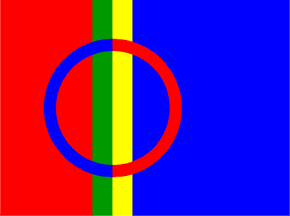Sami Alphabet in The Norwegian Curriculum
 Today the Norwegian social-democratic Minister of Work and Integration Bjarne Håkon Hanssen officially opened the «Sami Finger Posts», created to help the teaching of the Sami alphabet
Today the Norwegian social-democratic Minister of Work and Integration Bjarne Håkon Hanssen officially opened the «Sami Finger Posts», created to help the teaching of the Sami alphabet in Norwegian schools. He did this by going back to the school desks at Slemdal skole to learn the Northern Sami alphabet in a class of twelve year olds.
in Norwegian schools. He did this by going back to the school desks at Slemdal skole to learn the Northern Sami alphabet in a class of twelve year olds.In the summer of last year it became public that the Sami alphabet was added to the Norwegian curriculum for the seventh grade of the primary school. This led of course to quite some discussions, in which especially party president Siv Jensen
 of the Progress Party (Fremskrittspartiet) was noticed saying she didn't even know Sami was an official language in Norway, and that she didn't know whether she should laugh or cry. A lot of people didn't know in their turn whether they were supposed to laugh or cry with Siv Jensen's remark.
of the Progress Party (Fremskrittspartiet) was noticed saying she didn't even know Sami was an official language in Norway, and that she didn't know whether she should laugh or cry. A lot of people didn't know in their turn whether they were supposed to laugh or cry with Siv Jensen's remark.A lot of response came from a number of pedagogues too. In their typical May '68 style they proclaimed that learning the Sami alphabet was just a waste of time. Learning any information at all is actually taboo in the Norwegian schools: pupils do not attend school to learn things, but to acquire social skills and have fun. It may therefore not come as a surprise that in international tests, Norwegian education usually doesn't score very high, especially when compared to its neighbor Finland, where old fashioned concepts like diligence and discipline aren't banned from school yet. They even teach Latin there! As a comparison: if I really want to scare my colleagues, I tell them I had six years of Latin during secondary school. This doesn't mean that these Norwegian pedagogues become somewhat humble when they are confronted with those international comparisons: each time the Norwegian education system gets a bad mark, they are quick to point out that the social merits of the Norwegian system isn't taken into account in those tests. I don't think they'll ever get it.
There's of course another problem: thousands of teachers who have never learned the Sami alphabet, let alone anything more about the Sami language than that it's awfully difficult, will have to teach the Sami alphabet to their pupils. But that raises the question how that Sami alphabet looks like. Is it like Chinese, with thousands of strange little drawings? Or is it more like Cyrillic or Georgian, consisting of a dozen or two of funny scribblings that look like letters? Well no, because even though there are three variants of it, it is based on the Latin alphabet, just like the Norwegian, and most of the letters are actually completely identical to the Norwegian. One can therefore wonder what a teacher is doing in front of a class-room if he can't figure the Sami alphabet out in an evening or two, and whether it really will hurt these twelve year olds children that much if they will be confronted with it for a few hours. I'm actually more surprised --but maybe that's just my Flemish reflex speaking-- that they're not supposed to learn more, like some basic grammar and a bit of vocabulary, so they would be able to say hello to their fellow-countrymen if they would happen to end up in the far North one day. But perhaps that's not the sort of social skills that fits will in the world of those Norwegian pedagogues, because then those poor children actually will have to learn something at school…
 Tag at del.icio.us
Tag at del.icio.us
